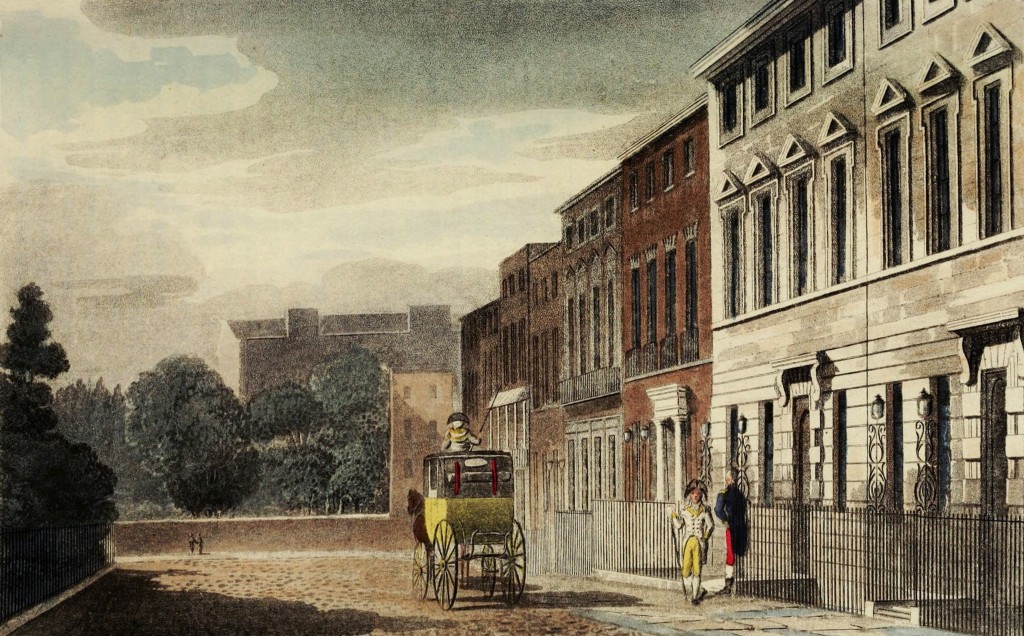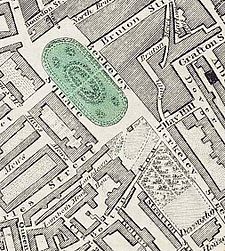
Fans of the Regency will oft see places mentioned in the pages of their Reg Rom, and perhaps not know the real deal. As an author, I have delved the pages of history to research peoples and places for accuracy and to enhance my stories.

This week, I would like to highlight a well used but seldom explained Regency hot spot: Gunter’s Tea Shop.
Located in London’s Berkeley Square, it became a fashionable light eatery in Mayfair, notable for its ices and sorbets, after James Gunter took over in 1799 as sole proprietor. At No. 7-8 Berkeley Square, the shop had eating space, but it became the fashion for everyone to take their ices outside and into carriages or in the square itself.
“The ton flocked to Gunter’s to enjoy his ices and sorbets. The practice of eating the confections outside in the Square itself developed. Since the customers were served in the Square, waiters were obliged to dodge across the road taking and carrying their orders. Gunter’s Tea Shop was the only establishment where a lady could be seen eating alone with a gentleman who was not a relative without harming her reputation. The ladies would remain seated in the carriages in the shade of the Maples. Their gentlemen escorts would step down from their equipages and come round to the passenger side of the curricle or barouche and lean against the Square’s railings sharing the lady’s company and the treat.
James Gunter had founded a sweet empire that would continue to be run by his family for several generations. His wealth would enable him to own a fine mansion in Earl’s Court that came to be called “Current Jelly Hall.” (Georgian Index)
Gunter’s sign was denoted by a pineapple, and no doubt crowded on a warm day during the Season.
Ices came in a variety of flavors and textures. Here is a great description I found Historic Foods.com:
“A dessert… was not complete without a good variety of ices, the most fashionable of all sweet dishes of the period…Liqueurs glacées, rather like granita in texture, were the oldest and most primitive and were at this period giving way to the more sophisticated neiges, fromages glacés and mousses. Neiges were rather like our modern ices, though often sweeter, and were spooned directly from the cooler (seau à glaces) into the little serving cups (tasses à glaces). These are represented on the right-hand console by the soft green neige de pistachio, the bright pink glace de épine-vinette (barberry) and the creamy glace au pain de seigle (rye bread), the precursor of the brown bread ice so popular today. Various flavours were frozen in pewter and lead moulds to create novely ices in the form of fruits (fruits glacés), vegetables, cuts of meat and even animals. Fake biscuits and canelons moulded in ice cream were also very popular at this period. Powder colours were usually painted onto the inside of the moulds before the ice cream mixture was spooned in. We have used surviving pewter moulds of this type to create the replica fruits glacés on the left-hand console, which include a melon, pears, apples, apricots and pineapples. The asparagus ices are made from a mould identical to one illustrated in Gillier’s Cannameliste of 1750. The craze for these shaped ices survived well into the twentieth century, until concern with a possible threat to health from the lead in the moulds made them unfashionable. Fromages glacés were rich custard ices frozen in moulds in the shape of cheeses. Mousses were lightly frozen creams, popular flavours being vanilla, saffron and ambergris.”
Did anyone else see that? Meat shaped ice cream? YUCK! I believe more popular were regular old scoops of Gunter’s flavors: bergamot, lavender, maple and chocolate (which was probably a stronger, darker version than we are used to today).

Vitals:
| Gunter’s Tea Shop | confectioner | 7 & 8 Berkeley Square | ices, wedding cakes | The sign of the Pineapple | Mayfair | 1799-1930’s |












Pingback: Seen Over the Ether: Regency Hot Spots « Jane Austen’s World
Pingback: Seen Over the Ether: Regency Hot Spots « Jane Austen’s World
Pingback: Fun Facts in Honor of July ‘National Ice Cream Month’ « Art & History Tour
Pingback: Fun Facts in Honor of July ‘National Ice Cream Month’ « Art & History Tour